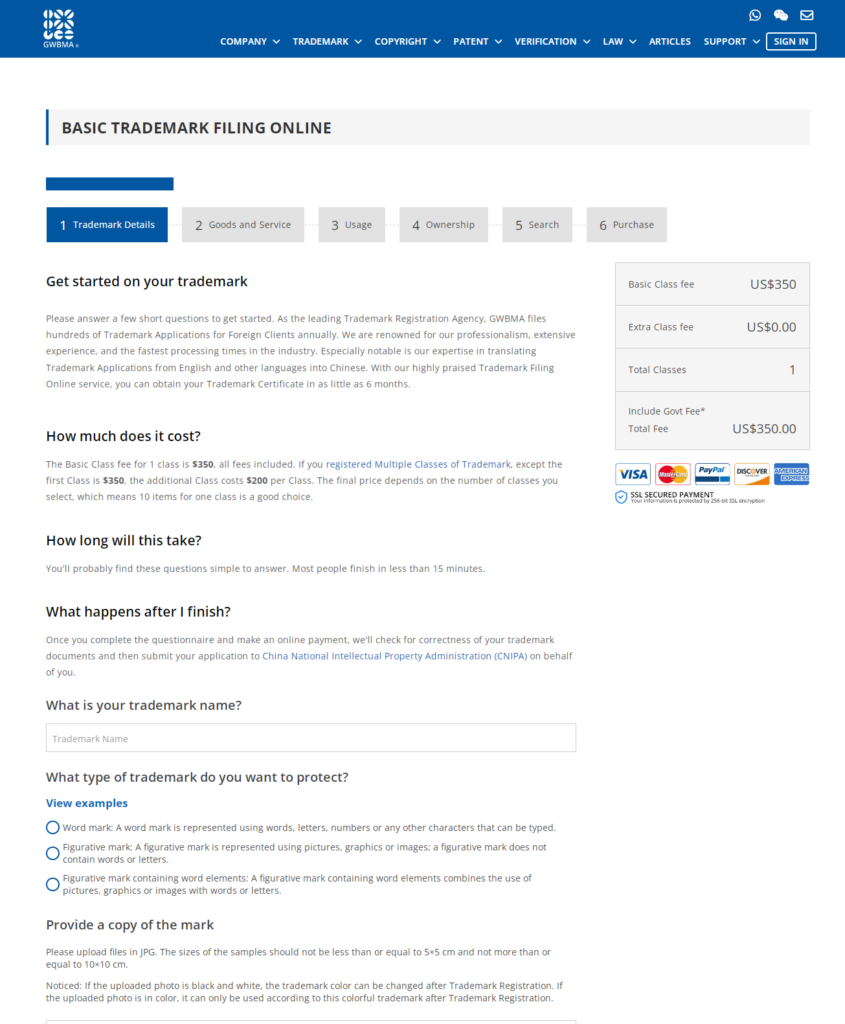Contents
Introduction:
In the process of trademark registration in China, many foreign applicants misunderstand the local regulations, thinking that selecting as many goods or services as possible under one class will provide comprehensive protection. However, this approach not only increases costs but can also delay the registration process and create legal risks. Choosing 10 items in one class is the most cost-effective and efficient strategy under China’s Trademark Registration System .
This article provides a step-by-step guide to understanding China’s trademark rules, explains why choosing 10 items is optimal, and highlights how to simplify the process through professional services like GWBMA. For businesses seeking protection in China, this insight can ensure timely and accurate trademark registration, safeguarding your brand assets.
Understanding China’s Trademark Registration System
Understanding China’s Trademark Registration System
China follows the Nice Classification system, which divides goods and services into 45 classes. Each class is further broken into specific items. For instance:
- Class 30 includes items such as “coffee, tea, sugar, and confectionery.”
- Class 33 covers alcoholic beverages like “wine, whiskey, and beer.”
Key Features of China’s System
- Fee Structure:
- The base fee includes up to 10 items per class. Beyond this, each additional item costs RMB 15 (approximately $2) for CNIPA. For example, registering 40 items would incur an extra fee of RMB 450 ($60).
- Document Requirements:
- Foreign applicants must provide identification documents, such as a passport (for individuals) or business license (for companies). These must be translated into Chinese.
- Professional translation services are essential to ensure compliance with China’s requirements.
- Language Requirements:
- All application materials, including descriptions of goods or services, must be submitted in Chinese. English descriptions must be translated, adding to the processing time and complexity.
Choosing 10 Items in One Class is the Best Choice
Cost Efficiency
Choosing 10 items avoids additional fees and simplifies the registration process. This is particularly important for businesses with limited budgets or those testing the market in China.
Focus on Core Business
The purpose of trademark registration is to protect the core goods and services of a business. For instance:
- A coffee company should prioritize “coffee, tea, and related products” rather than diluting resources on unrelated items like “sauces or spices.”
Minimize Legal Risks
Unused trademarks in China can be challenged and revoked under the three-year non-use rule. By selecting only relevant items, businesses reduce the risk of non-use cancellation.
Faster Processing Time
Applications with fewer items are easier for examiners to review, potentially speeding up the process. Opting for 10 items avoids unnecessary delays caused by overly broad applications.
Required Documents for Foreign Applicants in China
To register a trademark in China, foreign applicants must prepare the following documents:
- Passport or Business License:
- Individuals must provide a scanned copy of their passport.
- Companies must submit a copy of their business registration certificate.
- Translated Documents:
- All documents must be professionally translated into Chinese, including goods/services descriptions. Proper translation ensures compliance and avoids rejection or delays.
- Power of Attorney (POA):
- Foreign applicants are required to appoint a local agent (registered in China) to handle the application process.
Why Work with a China-Based Trademark Agent
Local Expertise
Registered trademark agents in China, l have deep knowledge of local laws and procedures, ensuring accurate and efficient applications.
Transparent Fees
GWBMA offers a clear and competitive pricing structure:
- First class registration fee: $350
- Each additional class: $200
These fees include professional guidance, document preparation, and application submission.
Speed and Efficiency
Direct applications through Chinese agents typically result in faster processing times. With GWBMA, businesses can expect to receive their trademark certificate in 6 months or less, significantly faster than alternative methods like the WIPO Madrid System.
Case Studies: Choosing 10 Items in One Class and Multiple Classes in China
Case 1: Single-Class Registration
A U.S.-based coffee company wanted to protect its core products in China. With guidance from GWBMA:
- They registered in Class 30 with 10 key items, including “coffee, tea, and confectionery.”
- Total cost: $350.
- Result: Trademark certificate issued in just 6 months, providing solid protection for their product line.
Case 2: Multi-Class Registration
An international food and beverage company planned to launch a range of products in China. GWBMA helped them register across three classes:
- Class 30: “Coffee, tea, sugar, and baked goods.”
- Class 32: “Non-alcoholic beverages, fruit juices, and mineral water.”
- Class 33: “Wine, whiskey, and beer.”
- Total cost: $750 ($350 for the first class, $200 each for the second and third classes).
- Result: All three classes were approved within 6 months, enabling the company to expand its product lines with full legal protection.
Tips for Strategic Trademark Registration in China
- Prioritize Core Items
Focus on goods and services directly tied to your business operations. Avoid registering unrelated items to save time and costs. - Consider Future Growth
If expanding into additional product categories, plan for multiple classes upfront to lock in protection. - Partner with Professional Agents
Working with trusted agents like GWBMA ensures smooth application processes, transparent pricing, and compliance with Chinese regulations.
Conclusion:
In China, choosing 10 items per class is the smartest approach for cost-effective and efficient trademark registration. For businesses seeking multiple classes, partnering with professional agents like GWBMA ensures transparency, accuracy, and speed. With clear pricing and expertise, GWBMA can help secure your brand’s legal protection in as little as 6 months.
Registering a trademark isn’t just about compliance; it’s about protecting your brand and unlocking the potential of China’s vast market. Take the first step today and ensure your trademark strategy is as strong as your business vision.



